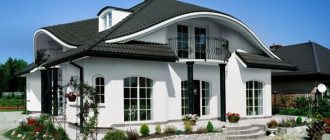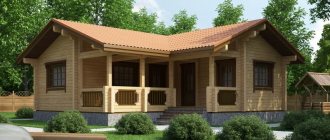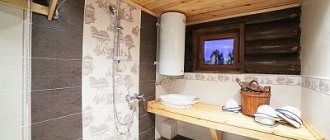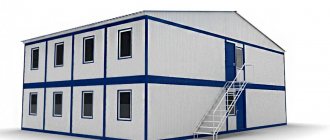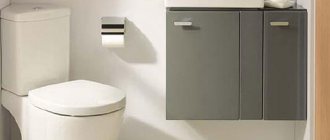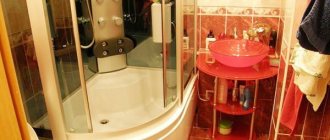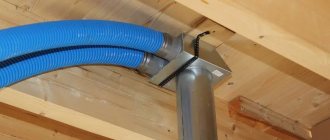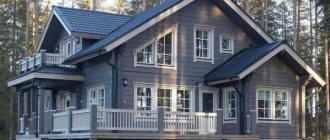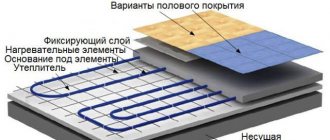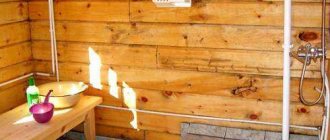Rednasty
27674 0 6
Rednasty November 2, 2016I'm not a wizard, I'm just learning. But I know everything about interior styles, comfortable home improvement and the transformation of Khrushchev’s apartments into luxury apartments. Hobbies: I like to give good advice.
The dacha is a truly cozy place where you want to return again and again!
In our realities, large investments in dacha repairs look quite unproductive. On the one hand, is it worth spending a lot on furnishing a home in which we spend at most several months? On the other hand, no one can cancel the completely reasonable desire for a cozy place in their “country estate”.
Decorating a country house can look simple and neat
If you are interested in simple materials and budget solutions that can improve and decorate your dacha, then this article is definitely for you. In it, I will analyze the main inexpensive methods of wall cladding and share several creative options for creating an original country interior.
Design features of facade systems
All types of facade finishing can be divided into two groups:
- thermal insulation – multilayer systems based on insulation, designed to minimize heat loss, increase energy efficiency and decorativeness of the building;
- protective and decorative - multi-layer systems or single-layer materials to protect the building envelope from external factors and increase the attractiveness of the house.
Both thermal insulation and protective and decorative facades come in two types:
- wet - the device technology involves the use of construction and finishing mixtures (masonry mortar, adhesive mixtures, rough plaster, decorative plaster);
- hinged - fixation of system elements is carried out mechanically, in a dry way, using subsystems (lathing, counter-lattice) and hardware (screws, dowels, clamps).
Curtain facades with thermal insulation are always ventilated - air circulation from bottom to top is necessary to maintain the insulation in a dry state. If we are talking about a hinged protective and decorative facade, a ventilation gap is not needed; the cladding is attached either directly to the base or to a subsystem.
Preliminary work
During preliminary work, before finishing the attic, low walls are built along the edges of the room. At the same time, installing ceiling windows is a fairly practical solution.
The attic is a full-fledged living space, so for the comfort of living in it it is necessary to carry out insulation. Finishing will make the premises more comfortable. With a complete renovation and finishing of the attic space, the owners of the house receive additional living space.
During finishing work, it is important to adhere to the following principles:
- Stingrays must be protected as much as possible from wind and precipitation. It is necessary that they withstand serious temperature changes.
- Thermal insulation of the roof is carried out both indoors and outdoors. This increases the protection of premises from freezing and drafts.
- To insulate the attic, in addition to the insulation material, it is necessary to prepare sheets of plasterboard. Cement particle boards are suitable for finishing.
- The insulation pie includes a vapor barrier and a windproof layer.
Elements of the rafter system can become a decorative decoration for the attic space.
Types of facade finishing
Houses of the previous generation could not boast of a wide variety of facades - red brick cladding (ceramics), white brick cladding (silicate), cement-sand plaster coat, paint (panel and wooden houses). Considering that they were built primarily from brick, panels and logs, there was no particular need for other finishing options. With the advent of frame technology and various large-format blocks aimed at mandatory finishing, demand has increased and supply has appeared. The classics have not gone away, both brick and wooden housing construction are at their peak, but several spectacular and effective ways to protect and transform buildings have been added. It is problematic to list all the possible options for decorative finishing of the facade of a house; something original always appears, so let’s look at the most popular ones.
- Siding.
- Facade panels.
- Wood cladding.
- Decorative plaster.
- Brick cladding.
- Tiles on the facade.
- Stone cladding.
Preparatory stage
- First of all, clear the floor of all things and objects, dirt and dust. Inspect the rafters and sheathing, perhaps repair them, re-impregnate all the wood with products to protect it.
- To prevent it from being hot on the second floor in summer and cold in winter - when using the attic floor in winter, you need to insulate the roof before covering it internally.
- Before laying insulation (mineral wool, for example) under the roof, do not forget to lay a waterproofing layer under the roofing layer, and after laying the insulation, provide an anti-condensation film (vapor barrier).
- We also insulate the floor accordingly. The technology and sequence of work, the materials used are described in detail in the article - how to insulate a floor.
Siding
This category unites a large group of materials for facade cladding with common characteristic features:
- long typesetting panels imitating a wooden board or log;
- fixation of type-setting elements with hardware to a wooden, metal or polymer subsystem (curtain façade);
- high decorativeness - the cladding does not require additional manipulations; after assembly, a completed facade is obtained without the need for treatment with protective and decorative compounds.
Modern siding comes in several varieties.
Vinyl
Produced from polyvinyl chloride (PVC) using the extrusion method, previously the material was characterized by low color fastness and fragility. Today's polymers have improved significantly technically; even in dark collections, the color saturation remains for years, and the resistance to mechanical stress is an order of magnitude higher. In addition to regular vinyl siding, manufacturers offer foam siding, which is thicker, stronger and more durable. Both vinyl and foam siding have a number of advantages.
- Presentable – a large selection of textures and colors, a fairly high level of imitation, thanks to the textured surface.
- Durability - the polymer is resistant to temperature, moisture, and is not subject to corrosion.
- Versatility - due to its low weight and installation method, it can be used on almost any type of base, both with and without insulation.
- Ease of installation - assembly of the subsystem and the cladding itself does not require expensive equipment and professional skills; you can do it yourself. Due to the absence of wet processes, facade finishing with siding is carried out almost all year round.
Three times DadForumHouse Member
Vinyl siding, herringbone, blueberry, the facade was made by myself, on a wooden block.
The disadvantages of siding are largely related to its quality - budget cladding can fade, crack in the cold, and can warp and warp due to severe overheating. Not everyone likes the appearance of siding, but this is purely a matter of taste and financial capabilities; the original is always cooler than the imitation, but also more expensive.
Metal
Corrosion-resistant aluminum siding is the prerogative of public buildings; in the private sphere it is used in combined facades, in fragments. As the main cladding, steel siding with a polymer protective and decorative coating is in demand. Metal also imitates natural wood, most often it is a board, beam, block house or log, but only in profile and pattern, and not in texture. The advantages of metal siding include durability with decorativeness, and versatility with ease of installation. Plus, the metal is not afraid of mechanical stress, does not burn or crack in the cold, and even exceeds its vinyl counterparts in terms of service life.
viktor5000FORUMHOUSE Member
I started decorating at the beginning of winter, half of the house is ready. I’m posting photos for variety, otherwise when I was looking for options, there were few samples on the Internet. Metal is absolutely everywhere: the roof, walls, soffits and trim on windows and doors. There is not a single plastic part.
But damage to the protective layer during installation or operation is fraught with the appearance of corrosion, and rust does not paint any façade. During the work, extreme care must be taken so as not to block all the advantages of the material by careless installation.
Fiber cement
It is made from a mixture of cement binder and reinforcing fiber (fiber, mainly cellulose, but other inclusions are possible) by autoclave hardening. The production cycle allows us to obtain a surface that is as close as possible to wood in texture. The installation technology is standard, usually a wooden or metal subsystem; extensions can be either special or homemade. Fiber cement on the facade is combined with natural wood, stone and plaster. The strength, durability and wear resistance of fiber cement boards is higher than that of vinyl, while metal is inferior in reliability, but this type of siding is the most expensive in terms of cost. The relatively large mass (15-18 m²) is not a drawback; any foundation, be it a monolith, masonry or wooden frame, can withstand such weight. Installation of fiber cement cladding is somewhat more complicated, since the boards are only single and cutting is more labor-intensive, but it is also quite possible to carry out all the manipulations on your own.
Ilya1005FORUMHOUSE Member
The house was covered with fiber cement siding; the workers liked the material. For those who are just going to do this: don’t use branded paint for the ends, you can tint acrylic water-dispersed paint in the desired color, it will be a lot cheaper. Self-tapping screws are also excellent in the hypermarket (800 rubles for 500 pcs.) The manufacturing company has self-tapping screws for 3,200 rubles for 500. You can save a little.
Why did my friend and I start studying materials?
Vadik and I each have several aunties who have no one to help except their nephews. At the beginning of spring, we began to prepare for the summer season. We need to start putting the dachas in order. The most labor-intensive work was finishing the walls inside. It is necessary to choose a material that allows the walls to breathe. It is advisable to maintain the design style.
The task was complicated by the fact that no one lived at the dacha in winter. The room was not heated. Our relatives could not spend a lot of money on decorating the inside. We will do the work ourselves, but the material must be purchased inexpensively. It is easier to choose a combination of price and quality than the cost of the material and its naturalness and environmental friendliness.
I told Vadik about different finishing materials for wooden houses. As a result, he compiled a table that can be used as a basis when choosing an option for covering wooden walls in a country house.
| Positive qualities of the material | Negative qualities of cladding | Where finishing should not be applied |
| drywall | ||
| price | hygroscopicity low vapor permeability | at seasonal dachas |
| ease of installation | need for plastering | in buildings that have not shrinked |
| low vapor permeability | ||
| gypsum fiber sheets | ||
| price | destruction at joints | Unheated dachas |
| flexibility | reduced vapor permeability | did not shrink |
| easy installation | reduction in environmental friendliness | |
| laminate | ||
| durability | the walls don't breathe | unheated rooms |
| high cost of installation and materials | bedrooms and children's rooms | |
| cork panels | ||
| environmentally friendly | very expensive | in damp areas |
| durable | fragile | boiler rooms |
| aesthetically pleasing | ||
| lining | ||
| environmentally friendly material | high price | boiler rooms |
| durability | fire hazard | damp areas |
| plastic | ||
| aesthetic appearance | ||
| MDF | ||
| average cost | low ductility | seasonal buildings |
| environmental friendliness | hygroscopicity | damp areas |
| high vapor permeability | fire hazardous areas | |
| no deformation | ||
| plywood | ||
| plastic | presence of glue | in damp areas |
| naturalness | hygroscopicity | |
| price | sealing joints | |
| OSB boards | ||
| environmental friendliness | contains formaldehyde | bedrooms |
| no deformation | cutting dust | children's rooms |
| low cost | ||
| wooden lining | ||
| naturalness | breaks down due to temperature changes | Unheated premises |
| easy to process | lit | |
| aesthetic appearance | ||
| block house | ||
| average cost | difficult installation on the casing | damp rooms |
| natural wood | ||
| aesthetic appearance | ||
| glass magnesium sheet | ||
| cheap | requires coverage | children's rooms |
| easy | low vapor permeability | bedrooms |
| flexible |
Natural materials are more expensive. Savings are achieved due to the lack of finishing of the walls after cladding. There is no need to plaster, glue or paint.
Facade panels
Initially produced specifically for the base, they are characterized by increased strength and resistance to all types of influences, from atmospheric to mechanical. If the siding imitates wood, both in shape and appearance, then the panels repeat fragments of brick or stone cladding; there are also collections for a plaster facade, but less often. The surface can be either smooth, like facing ceramic bricks, or textured, like hand-molded bricks and various types of stone. Panels, like siding, are of several types.
- Polymer - apart from the type, they differ from vinyl siding in greater thickness.
- Fiber cement - the only difference is in shape and texture.
DusyaChashkinaFORUMHOUSE participant
The facade is finished with panels - Japanese, fiber cement, metal subsystem, expensive, but beautiful. All that remains is to finish the blind area. I'm happy with the result!
It is worth considering thermal panels separately, since this relatively new material for facade finishing is both insulation and decorative screen. Unlike polymer and fiber cement panels, thermal panels are fixed directly to the base with glue (adhesive foam) and mechanically, without a subsystem. The thermal insulation layer can be polystyrene foam (EPS), extruded polystyrene foam (EPS, XPS) or polyurethane foam (PPU). The front decorative part is usually made of clinker or ceramic tiles, printed concrete or flexible stone (a combination of acrylic polymer and quartz sand or marble chips).
Vyacheslav715FORUMHOUSE Member
A frame house (OSB exterior cladding) was lined with thermal panels made of polystyrene foam (60 mm) with German clinker tiles in 2003. There are no defects in the facade. They haven’t opened it, but there are no signs of damage (odor, mold, etc.) in the house, photo – winter 2022.
Wood cladding
Wooden cladding is classified as siding, which is not entirely correct - siding is an imitation of wood, not a natural finish. The most common are several types of wood cladding.
- Board - both planed and unplaned boards are used, the orientation is predominantly horizontal butt-joint or overlapped (American), but vertical cladding based on Scandinavian motifs is also found.
- Planken - usually made of larch, a perfectly smooth board with hewn edges and edges, is rarely used as the main material due to its high cost, and is mainly combined with other types of facade finishing.
- Lining is the most common interior wooden finish, but it is also widely used on the facade, the difference is in the type of wood (coniferous is desirable for the street) and thickness (15-25 mm). The lining is a dry, profiled board planed on all sides with a tongue-and-groove system, just like siding.
- Imitation of timber - most often made from coniferous wood, like lining, this type of board has a tongue-and-groove system, plus side chamfers cut at an angle of 40˚. It is used for both interior and exterior decoration, the only difference being the thickness of the planks (20-40 mm). After installation, the facade is indistinguishable from the facade of a house assembled from real profiled timber.
- Block house is also an imitation, mainly external, but not of timber, but of logs, the difference from lining and imitation timber is only in the semi-cylindrical profile shape. From afar, the façade of a block house is indistinguishable from a log house; up close, the ideal geometry and uniform size will be noticeable, which is uncharacteristic even for a rounded log, not to mention a hand-cut one.
- Shingles - unlike the bulk of wood trim, this is small-piece cladding in the form of plates, 5-10 mm thick, up to 400 mm long and 150-20 mm wide. The name of the material is due to the manufacturing method - they “tear” the chock, breaking off dies from it.
Regardless of the type, wooden cladding is attached to the sheathing and hardware (nails, clamps, etc.). The most popular is wood cladding of frames and wooden houses after insulation, but the base can be almost anything. The advantages of natural cladding include:
- Environmentally friendly.
- Decorative.
- Easy to install.
- Resistant to temperature changes and mechanical stress.
The main disadvantages are the relatively short service life, high cost and the need for additional protective and decorative treatment. And such treatment must be repeated every few years, the specific interval depends on the type and quality of the chosen product. Covering paints stay on the facade longer than glazing compounds and impregnations, but not everyone wants to hide the original texture.
Zack75FORUMHOUSE Member
Chopped larch shingles of decent quality and geometry, the dies were attached to the sheathing with special nails with a D-shaped head and a nailer. This is what ended up happening. Bast hut!
I think the idea with rounded corners is especially cool. By the way, it’s easier to match the walls this way. Somehow I didn’t quite understand how to make the outer corners of the shingles, otherwise it would have been difficult and less interesting, IMHO.
How to finish the floor and ceiling
When choosing a material for finishing a dacha, you may prefer laminate. Its installation involves laying the substrate and insulation. This will prevent contact of the finishing coating with the rough surface and exposure of the laminate to moisture. When tiling the floor with your own hands, you need to figure out what material is the basis of the rough coating. This will allow you to understand whether a waterproofing layer is needed. You cannot do without laying insulation if installation work is carried out according to:
- concrete floor;
- monolithic ceiling;
- cement-sand screed;
- factory plates.
Finishing the dacha floor with laminate must begin from the window, moving perpendicularly. It is important to provide a gap between the wall and the laminate by placing spacer wedges there. Their width should be 10 mm. The gaps are necessary to allow the covering to expand and contract as indoor conditions change.
When finishing the floor in a cottage room, you will need to cut the panel in the second row to start with a short element and get a staggered arrangement of slats. If the trimmed part is larger than 50 cm, it can be placed in the second row, minimizing waste. The boards are applied to adjacent panels at an angle of 45˚.
When finishing the floor with your own hands, you will need to lay the last panel using a clamp, which will keep the system in a stationary state. After installation, the deformation gap is closed with skirting boards.
When decorating the interior of a dacha, you also need to think about the ceiling. It can be refined using paint, tiles or a hemming system. A dacha room in the ceiling area is sometimes also finished with clapboard. You can use the same drywall, which is used not only for standard leveling, but also for creating multi-level beautiful systems.
When choosing materials for your home, you should also pay attention to plastic panels. The algorithm for their installation is similar to the technology for installing lining. Foam boards that cope well with aggressive conditions, such as moisture or changing temperature conditions, will look great. The interior of a country house will look simple with such decoration, but it will cost quite cheap.
Plastic on the ceiling can retain an attractive appearance for a long time, and additional advantages are low cost and the possibility of self-installation. After all, one cannot but agree with the fact that suspended ceilings are also a budget design idea, but their installation is impossible without the appropriate equipment and skills.
You can’t just focus on cost, because ceiling panels can only be glued to a flat surface. The base must also be prepared, otherwise the tiles will not lie tightly, and already at the repair stage noticeable defects will appear at the joints. Therefore, before finishing the ceiling, you need to evaluate its quality and evenness, as well as its appearance. If smudges are noticeable here and there, you will also need to get rid of them.
Decorative plaster
Wet facade, mainly within the framework of composite insulation systems, although decorative plaster can also be applied to a prepared base without a layer of thermal insulation. In SFTK (facade thermal insulation composite system) the “pie” is standard.
- Insulation – expanded polystyrene (PSB), stone wool slabs, mineral wool slabs (high density).
- The reinforcing layer is an adhesive composition with a fiberglass mesh embedded in it; it is also called the base or anti-vandal layer.
- Decorative plaster - applied using various techniques, depending on the type of plaster mixture, the texture is expressed with a “pattern”, or homogeneous with a slight relief. After application, the facade is primed and painted.
The popularity of finishing facades with plaster in the private sector is explained by a number of advantages.
- Increasing the energy efficiency of buildings at any stage of finishing - both during construction and after several seasons.
- Highly decorative - a lot of design options, various patterns and a wide range of colors, the ability to change the architecture and proportions (visually) through applied decor (homemade or factory moldings).
- Wear resistance – resistance to both temperature fluctuations, moisture, and mechanical stress.
- Durability - the original appearance of a wet facade can be preserved for decades; painting is enough to update it.
- Ease of execution - if desired, almost anyone can learn how to “twist a bark beetle,” and the level of skill does not always depend on experience.
However, all of the above advantages “work” only if the type and thickness of insulation is correctly selected, the quality of all system materials is good, and the technological process is followed. The fragility, staining, peeling and cracking of plaster attributed to this type of finish are the result of violations of the stated conditions.
Initially, the finishing layer of the wet facade was only cement-based mineral plasters, with the addition of stone granulate of different fractions. And the most common type of pattern, bark beetle, also known as rain, is clear grooves formed by the vertical movement of granulate in the thickness of the plaster layer. Today there are more decorative plasters and patterns, there is plenty to choose from.
- Acrylic - the main difference between this type of plaster and mineral plaster is its high elasticity, which is especially important if movement of the base is possible. But acrylic compounds cannot be applied to bases made of stone or mineral wool slabs, since their vapor permeability is lower than that of these insulation materials.
- Silicone - in terms of wear resistance and durability, they are superior to both mineral and acrylic compositions; they practically do not absorb dirt, due to which dust from the facade is washed off during rain and the facade does not require maintenance.
If insulation of the facade is not planned, but the task is to decorate the surface, not only mineral, acrylic and silicone plasters are used, but also silicate ones. Despite such advantages as elasticity, vapor permeability and wear resistance, their disadvantages include “selective” adhesion. If the base is not silicate, but made from other materials, you will have to spend money on a specialized primer. Plus, silicate compounds are more difficult to apply, especially when large volumes need to be plastered. Without a certain level of preparation, a beautiful facade may not work.
SFTK with decorative plaster are universal; under certain conditions, even frame frames can be finished, and the non-static nature of the base does not become a hindrance.
Brick cladding
Finishing the facade with brick is a classic that is always relevant if the price is not at the forefront. But the cladding is designed immediately, since the brick screen needs a solid foundation. When everything is according to plan, and not at once, free space is left on the foundation for facing bricks. Both walls run parallel, inside and out, using flexible ties or otherwise tied together. Based on the parameters of the wall material, the “pie” may include insulation (slab, backfill), or the masonry is carried out without thermal insulation. The presence or absence of a ventilation gap between the base and the cladding depends on the vapor permeability of the base. If it matches the materials, for example, when the box is made of rough brick or ceramic block, a ventazor is not needed. If the walls are made of aerated concrete, foam concrete, wood concrete, wood or other materials with high vapor permeability, a ventilation gap is required. Different types of bricks are used for cladding facades.
- Ceramic - mainly for facing, but masonry from backfill “a la Bavarian” is also possible.
- Clinker - ceramics, but with improved characteristics on all fronts, be it service life or presentation. The high price classifies the material as a premium finishing class.
- Silicate is an option for everyone, for dry regions.
- Hyper-pressed - does not allow water to pass through, surpasses even clinker in strength, has a lot of colors and textures, but is not widely used.
A brick facade, subject to the choice of high-quality bricks and masonry mortars, as well as adherence to technology, is a complete advantage.
- Durability.
- Strength.
- Reliability.
- Resistance to any atmospheric factors and mechanical influences.
- Presentability.
However, not everyone can cladding a house on their own, and invited “masters” often manage to make mistakes. Plus, the foundation must be designed for such weighting, because there are two boxes. Wetting of the facade, efflorescence, spalling and other “delights” are not shortcomings of brick facades, but poor quality bricks, increased salt content in masonry mortars, and disturbances during the masonry process.
AntonKananykhinFORUMHOUSE Member
I am sharing my experience of Bavarian masonry using domestically produced clinker bricks, maybe it will be useful to someone.
- It is impossible to choose a material in a store; you need to take brick samples (10 pieces), seam samples and go to the site to see how the masonry will look in natural light.
- To make it easier to match the color, it is advisable to take bricks from one firing batch.
- The geometry is far from ideal, closer to a boat shape, but this is not critical.
- Craftsmen will have to pay extra for laying clinker.
- Pallets usually contain more dark-colored bricks, which are best set aside and used in less visible areas.
Everything was fine; if you are a perfectionist and are willing to overpay considerably, it is better to pay attention to German clinker.
Brick
Brick walls look stylish and expensive, but do not cost as much as you might imagine: the price for 1 brick starts at 10 rubles, respectively, a square meter of covering will cost at least 500.
Yes, it is several times more expensive than plaster, but by covering the external wall of a building with brick you get:
- high strength;
- excellent thermal insulation;
- incomparable frost resistance;
- high sound insulation.
But brick still has one “but”: the total weight of the finish will be very heavy, so not every foundation will support it.
Tiles on the facade
A broad category that includes small-format and large-format tiles, used both as the main finish and in combination with other materials. Several types of facade tiles are most in demand.
- Concrete - produced in the form of large panels with a brick or natural stone texture, less often in the form of a single “stone”, mounted mainly on a subsystem (clamps, self-tapping screws). A large selection of textures, relatively simple installation, resistance to external influences and durability provide concrete tiles with stable popularity among private owners. Artificial stone for facade finishing, also a type of concrete tile.
- Ceramic (clinker) - when you want a facade made of clinker bricks, but the funds and skill are not enough, use clinker tiles, which have retained all the performance characteristics of the original and differ from it only in their smaller thickness. The method of fixation is adhesive, using specialized mixtures. Today, the finishing layer of clinker tiles is increasingly found on thermal panels and in thermal insulating composite facade systems.
- Porcelain tiles - there is no particular point in placing it in a separate category, since it is also a tile, only large and heavy, which is why it is mounted on a metal subsystem, like facade cassettes. In terms of strength and durability, porcelain stoneware is comparable to brick and stone, but this decoration of the facade of a private house is not particularly common. Porcelain tiles are much more suitable for cladding public buildings and high-rise buildings in modern business class residential complexes.
kisnikFORUMHOUSE Member
Aerated concrete house, insulation, concrete tiles with stone texture on a wooden subsystem. It was possible to do it yourself, quite easily, but there was neither time nor any particular desire to delve into and understand the material. That’s why I chose the turnkey option and I don’t regret it.
Economy Class Design Ideas
If you want to make cheap renovations at your dacha, the finishing can be done with a variety of materials. In this case, wallpaper is undoubtedly chosen for the walls. But you can do without them if you level the surface with plywood or OSB sheets.
When developing the design of the site, you should also think about the finishing of the floor. The simplest and most cost-effective finishing option for this part of the premises is linoleum. It is durable and practical. You can even lay it in rooms with high humidity. When leveling walls, it is better to give preference to a finishing material such as fiberboard. It is aesthetically pleasing and does not require additional cladding. You can only apply a special varnish at the final stage of repair. This finish is not only cheap, but also durable and resistant to various influences.
If you are on a limited budget, it is not recommended to take risks with rich and bright colors. It is better to focus on a composition based on neutral shades. The most relevant colors in modern styles are the following: beige, white, gray. They can have different textures, which will allow you to diversify the design of the dacha premises.
Stone on the facade
Stone is a heavy type of cladding, which somewhat limits its use and complicates the installation technology. Natural stone cladding is made from the following rocks:
- Sandstone;
- Limestone;
- Slate;
- Granite;
- Quartzite;
- Gabbro;
- Marble.
A stone façade is characterized by low vapor permeability, which is associated both with the low vapor permeability of the stone itself and with the presence of an adhesive layer in the system as an additional vapor barrier. Because of this, houses made of aerated concrete blocks and similar materials cannot be faced with stone directly, only in a facade insulation system. If the region is cold, like Moscow and the like, the house will need insulation from any material. Under the stone decorative layer in the SFTK double reinforcement is made:
- a layer of glue is applied to the insulation;
- reinforced armored fiberglass mesh with a density of 320 g/m² is embedded in the glue;
- through the first base layer (mesh and glue) disc-shaped dowels with a metal nail are driven into the PSB at the rate of 10-12 pieces per m²;
- another layer of glue in which a fiberglass mesh with a density of 145-165 g/m² is embedded;
- tightening the glue (so that the mesh is completely covered with the adhesive mixture).
The stone is glued onto the dried base using specialized adhesive mixtures, after which the seams are rubbed. To protect the stone façade from moisture, which it readily absorbs, water repellents or stone varnish are used.
Finishing the façade of a house with stone is exclusive, which is physically impossible to replicate, but the labor intensity exceeds even brick cladding. However, once, having spent time, effort and considerable money, you can forget about the facade for decades; it is not afraid of either weather conditions or physical influences.
ShufanForumHouse Member
Dagestan stone (sandstone) behaves well on facades even in humid climates. Over time, over twenty years, it may darken; to avoid this, it is enough to use a good impregnation.
Sheathing a house using sheathing
In general, there are two options for cladding a house:
- Directly onto the walls, protected from the inside by a layer of vapor barrier. In this case, lathing is not needed. In this way, plastering is often done on brick and reinforced concrete walls.
- On the sheathing. This is a ventilated facade system in which there is a gap between the finishing and the walls, in which, as a rule, the insulation is located.
We advise you to study in more detail: “All types of insulation: classification by properties and composition.”
The lathing is made of a metal profile or wooden blocks with a cross-section of 40x40 mm, a humidity of no more than 15-20% and impregnated with fire and bioprotection. Markings are made on the wall first.
Sheathing made of metal profile
On average, the lathing pitch is 300-400 mm, but it is important to consider the length (for vertical slats) and width (for horizontal slats) of the material used. Also, profiles must be attached around window and door openings.
A heat-insulating material is installed between the bars, which is secured with mushroom anchors. The insulation is covered on top with a superdiffusion membrane, fixed to the staples of a construction stapler. After this, you can begin sheathing.
We advise you to study in more detail : “FAKRO waterproofing membrane: its functions, scope of application, types and installation technology.”
Please note : for greater rigidity of the wooden sheathing, horizontal slats can be additionally attached between the main vertical bars.
Conclusion
The market has a huge selection of facade materials for every taste and budget, if the budget is limited - siding, panels, plaster or tiles. If the financial side of the issue is not critical and there is an opportunity to spend money on materials and performers - a facade made of brick or natural stone. Regardless of the variety, the materials must be of high quality, and the technology must be followed without a “collective farm”. In cases of outright disregard for the instructions and recommendations of manufacturers, problems will arise with any façade.
On the topic, you can read about the most beautiful and unusual facades of the portal’s participants, as well as about the brick cladding of a house made of aerated concrete and timber. The video contains expert advice on how to choose a facade.
Subscribe to our Telegram channelExclusive posts every week
